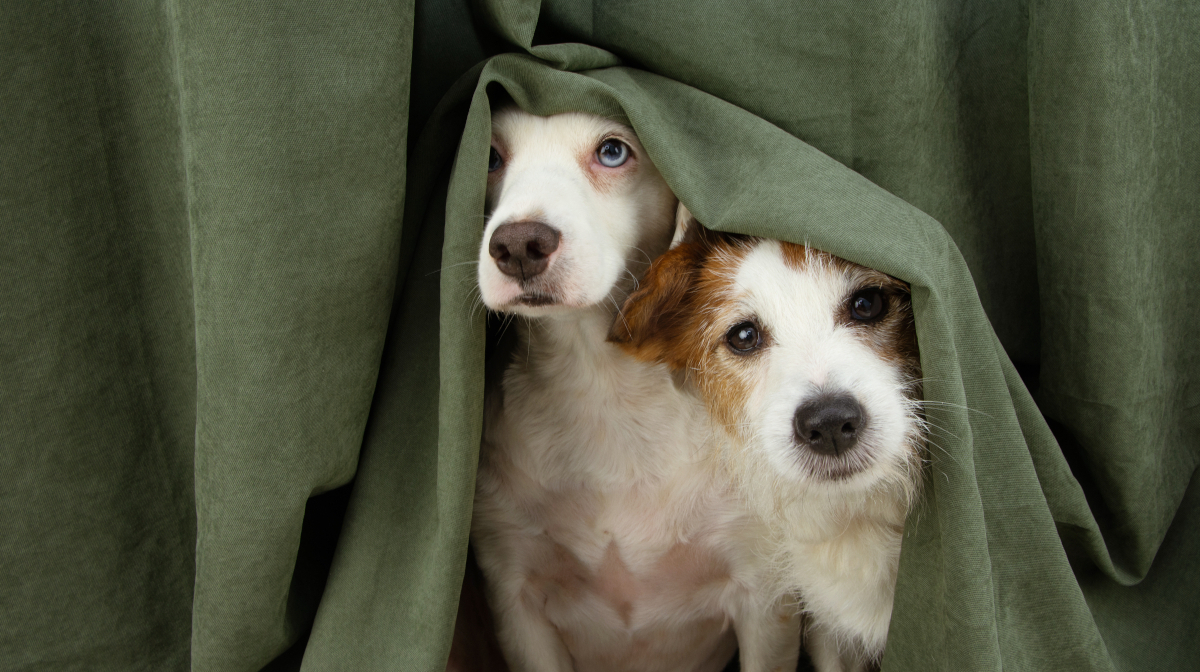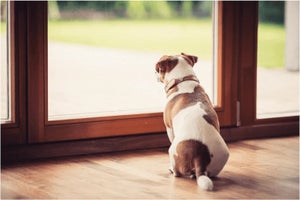
You've noticed your dog pacing restlessly around the living room, panting despite the cool temperature, or hiding behind the sofa when visitors arrive. These behaviours might seem puzzling, but they're often signs your furry friend is experiencing anxiety. Just like humans, dogs can feel overwhelmed by stress and uncertainty.
Learning how to calm an anxious dog helps you provide the comfort and support your pet needs during difficult moments. Dog anxiety is more common than many owners realise, affecting dogs of all ages and breeds. The good news is that with patience, the right knowledge, and a proper approach, you can help your anxious companion feel more secure and confident in their daily life.
Understanding Your Anxious Dog
Recognising when your dog feels anxious is the first step towards helping them feel more comfortable and secure. An anxious dog may display a range of behaviours that can sometimes be misinterpreted unless you understand the full context. These signs often appear subtle at first, making it crucial for pet owners to learn what to watch for in their beloved companions.
Anxiety in dogs can stem from various sources, and the way each individual dog responds can differ significantly. Some dogs become withdrawn and hide, while others may become overly clingy or destructive. The key lies in recognising that anxiety is your dog's natural response to situations they perceive as threatening or overwhelming, even when no real danger exists.
Learning to read your dog's body language and behaviour patterns helps you respond appropriately when they're feeling stressed. Dogs communicate primarily through their posture, facial expressions, and actions, so paying attention to these signals allows you to intervene before their anxiety escalates into more problematic behaviours.
Environmental factors, past experiences, and even genetics can all contribute to anxiety in dogs. Some dogs are naturally more sensitive to new situations, while others may develop anxiety following traumatic experiences or significant life changes. Knowing these contributing factors helps you learn how to calm a dog down instantly while managing their anxiety with patience and empathy.
The relationship between physical health and emotional wellbeing in dogs is also important to consider. Medical conditions such as pain, illness, or hormonal imbalances can lower a dog's threshold for anxiety, making them more susceptible to stress in situations they might normally handle well. This connection between physical and emotional health is why consulting with your veterinarian is often essential to addressing anxiety issues. If you're struggling to understand your dog and their behaviour patterns, professional guidance can provide valuable insights into their unique needs and personality.
What are signs of anxiety in dogs?
Learning about the signs of anxiety in your dog helps you provide timely support when they need it most. These symptoms can range from subtle changes in behaviour to more obvious physical manifestations that clearly indicate distress.
Physical Signs:● Panting and drooling: Excessive panting when not hot or exercising, often accompanied by increased drooling ● Trembling or shaking: Whole-body shaking that isn't related to cold temperatures or excitement ● Pacing and restlessness: Repetitive walking patterns, inability to settle in one place for long periods ● Changes in posture: Ears pinned back, tail tucked low, tense body carriage with weight centred over all four paws
Behavioural Changes:
● Hiding or withdrawal: Seeking shelter behind furniture, in corners, or behind their favourite person ● Excessive shedding: Increased hair loss during stressful situations, often noticeable at the vet's office ● Destructive behaviour: Chewing furniture, scratching at doors or windows, particularly around entry and exit points ● Bathroom accidents: House-trained dogs may urinate or defecate indoors when experiencing severe anxiety
Vocal and Social Signs:
● Increased vocalisation: Excessive barking, whining, or howling that's out of character for your dog ● Changes in social behaviour: Either becoming overly clingy and attention-seeking or avoiding interaction entirely ● Displacement behaviours: Normal activities performed out of context, such as excessive grooming or sniffing when stressed
Knowing dog noises meaning can also help you interpret whether your pet's vocalisations indicate anxiety or other emotions, helping you respond appropriately to their needs.
Why is My Dog Anxious?
Identifying the root causes of your dog's anxiety helps you address the problem more effectively and provide the needed support. Dogs can develop anxiety for numerous reasons, and often multiple factors contribute to their overall stress levels.
Separation-Related Causes:
● Separation anxiety: Fear and distress when left alone, often resulting in destructive behaviour or excessive vocalisation ● Changes in routine: Disruptions to daily schedules, new work patterns, or altered family dynamics ● Loss of companionship: Death or absence of family members, other pets, or significant people in their lives ● Environmental changes: Moving house, renovations, or significant alterations to their familiar surroundings
Fear-Based Triggers:
● Loud noises: Thunderstorms, fireworks, construction sounds, or other sudden, intense noises that can create lasting fear responses ● New experiences: Unfamiliar people, animals, objects, or situations that overwhelm their coping abilities ● Past trauma: Previous negative experiences that create lasting anxiety responses to similar situations ● Inadequate socialisation: Lack of positive exposure to various experiences during the critical puppy development period
Health and Age-Related Factors:
● Medical conditions: Pain from arthritis, dental disease, or other health issues that increase stress sensitivity ● Cognitive changes: Age-related mental decline that can increase confusion and anxiety in senior dogs ● Hormonal influences: Changes during heat cycles, pregnancy, or other hormonal fluctuations
Genetic and Breed Predispositions:
● Inherited tendencies: Some dogs are naturally more sensitive and prone to anxiety due to their genetic makeup ● Breed characteristics: Certain breeds may be more predisposed to specific types of anxiety or heightened sensitivity
Seasonal events can also trigger anxiety in many dogs. For instance, during fireworks season, you should understand how to provide bonfire night dog care as such specific triggers require expert strategies. Additionally, major life changes such as returning to work after extended periods at home can significantly impact your pet's emotional wellbeing, making it important to recognise separation anxiety in dogs and how to address these specific challenges.
How to Calm Your Dog
When your furry friend shows signs of anxiety, knowing how to calm a dog down instantly can improve their comfort and wellbeing. The approach you take depends on whether you're dealing with immediate distress or working towards managing the anxiety long-term. Quick intervention techniques can provide immediate relief during acute anxiety episodes, while ongoing strategies help build your dog's resilience and confidence over time.
Every dog responds differently to calming techniques, so what works for one anxious dog might not be as effective for another. This individual variation means you may need to try several approaches before finding the combination that works best for your pet. Patience plays a crucial role in this process, as both immediate and long-term strategies often require consistent application to achieve the best results.
The most effective anxiety management typically combines multiple approaches, rather than relying on a single solution. Environmental modifications, behavioural training, natural remedies, and sometimes veterinary intervention work together to create a comprehensive support system for your nervous dog. This multi-faceted approach addresses both the symptoms and underlying causes of anxiety.
Consistency in your response to your dog's anxiety helps them feel more secure and builds their trust in your ability to keep them safe. Dogs thrive on predictability, so establishing regular routines and consistent calming responses creates a foundation of security that can reduce overall anxiety levels. Remember that calming an anxious dog is often a gradual process that requires knowledge, patience, and sometimes professional guidance to achieve the best outcomes.
How to Instantly Calm Your Dog
When anxiety strikes suddenly, you need immediate strategies to help your dog feel safe and secure. These quick-response techniques can provide rapid relief during thunderstorms, fireworks, or other unexpected stressful situations. Knowing how to calm a dog down instantly gives you valuable tools for those moments when your pet needs immediate support.
1. Create immediate physical comfort: Thundershirts and anxiety wraps provide gentle, constant pressure that mimics being hugged, triggering the release of calming hormones like oxytocin. This pressure therapy works similarly to weighted blankets for humans and can provide noticeable relief within minutes of application. However, anything that creates additional warmth for a dog must be used with constant supervision and never in hot weather.
2. Use calming environmental changes: Move your dog to a quiet, dimly lit space away from the stressor. Playing classical music or white noise can mask anxiety-triggering sounds while providing a soothing auditory environment. Many apps and playlists are specifically curated to calm dogs and reduce barking triggered by environmental stressors.
3. Engage in distraction techniques: Offer high-value treats, favourite toys, or engage your dog in simple commands they know well. This redirection is essential when learning how to calm a dog down instantly, as it helps shift their focus away from the anxiety trigger while providing positive mental stimulation. Keep these distraction tools easily accessible for quick deployment when needed.
4. Provide a safe space retreat: Ensure your dog has access to their designated safe space, whether it's a crate with comfortable bedding, a quiet room, or their favourite corner with familiar blankets. This sanctuary should always be available and never used for punishment, maintaining its association with comfort and security.
5. Use calming scents and pheromones: Adaptil diffusers, sprays, or collars release synthetic pheromones that mimic the calming signals mother dogs provide to their puppies. These can be particularly effective during specific events like fireworks, especially when combined with other calming strategies from our bonfire night dog care guide.
6. Apply gentle physical contact: If your dog seeks comfort through touch, gentle petting or massage can help release tension and provide reassurance. However, avoid forcing physical contact on dogs who prefer to retreat, as this can increase their stress levels. Offering yourself as a calm, reassuring presence often helps more than overwhelming attention. High-value dog treats can also serve as positive distractions during stressful moments, helping redirect nervous energy towards something enjoyable.
Natural Remedies to Calm Your Anxious Dog
Natural approaches for how to calm an anxious dog naturally offer gentle, holistic alternatives that can complement behavioural strategies without the potential side effects of pharmaceutical medications. These remedies work by supporting your dog's natural ability to cope with stress while promoting overall emotional balance and well-being. Before trying any of these natural remedies, have a chat with your vet first. They’ll know what’s safe and suitable for your individual dog.
1. Herbal supplements and natural compounds: Alpha-casozepine (found in Zylkene) is derived from milk protein and has been scientifically shown to support calm behaviour in dogs. L-theanine, an amino acid found in supplements like Anxitane, helps promote relaxation without sedation. Valerian root contains valerenic acid, which increases GABA levels in the brain, naturally promoting relaxation and reducing anxiety responses.
2. Essential oils and aromatherapy: Lavender and chamomile essential oils contain compounds that naturally promote relaxation when properly diluted and used safely. Hydrosols (gentle alternatives to essential oils) can be misted lightly in the dog's environment to create a calming atmosphere. Never allow your dog to ingest essential oils, and ensure they can leave the area if they find the scent overwhelming.
3. Omega-3 fatty acids and nutritional support: These essential fats support brain health and can help reduce inflammation that may contribute to anxiety. Foods containing tryptophan (like turkey) naturally support serotonin production, which helps regulate mood and promote feelings of wellbeing. Some veterinary calming diets are specifically formulated with these beneficial nutrients.
4. Bach Flower Remedies and homeopathic support: Rescue Remedy, a blend of five Bach Flower essences, provides gentle emotional support during stressful situations. These flower essences are non-toxic, cannot be overdosed, and work to restore emotional balance naturally. They can be particularly helpful for vet visits, travel, or separation anxiety situations However, make sure to ask your vet for advice before administering to your dog.
5. Calming supplements with multiple ingredients designed for dogs: Many natural calming products combine several beneficial ingredients such as chamomile, lemon balm, passion flower, and B vitamins. These comprehensive formulations work synergistically to support your dog's natural stress response while providing additional nutritional benefits for overall health and well-being.
Long-term Solutions to Prevent Anxiety in Dogs
Building your dog's long-term resilience against anxiety requires consistent effort and a comprehensive approach that addresses both their physical and emotional needs. These strategies focus on creating lasting positive changes that help prevent anxiety from developing or escalating over time.
1. Establish consistent daily routines: Dogs thrive on predictability, and maintaining regular feeding times, exercise schedules, and sleep routines provides a foundation of security. This consistency helps reduce general anxiety levels by creating a stable environment where your dog knows what to expect throughout their day.
2. Provide adequate physical and mental stimulation: Regular exercise releases endorphins that naturally reduce stress and anxiety. So, it makes a great example of how to calm a dog down over time. Mental stimulation through puzzle toys, training sessions, and interactive games helps tire your dog's mind, leaving them more relaxed and content.
3. Implement gradual desensitisation training: Systematic exposure to anxiety triggers in controlled, positive ways helps your dog build confidence over time. Start with very mild versions of the trigger and gradually increase intensity while providing treats and positive reinforcement. This process requires patience but can significantly reduce your dog's sensitivity to specific stressors.
4. Practice independence training: Teaching your dog to be comfortable alone, even when you're home, helps prevent separation anxiety from developing. Start with very short periods in another room and gradually increase the duration. This builds their confidence in being independent and reduces clingy behaviour that can escalate into anxiety.
5. Use counterconditioning techniques: Associate anxiety triggers with positive experiences by pairing them with high-value treats, play, or other enjoyable activities. Over time, your dog learns to anticipate good things when encountering previous stressors, changing their emotional response from fear to anticipation.
6. Maintain proper socialisation and exposure: Ongoing positive exposure to new people, animals, environments, and situations throughout your dog's life helps prevent fear-based anxiety from developing. Keep these experiences positive and pressure-free, allowing your dog to explore and gain confidence at their own pace. For ongoing support during major life transitions, our guide on pet wellbeing after return to work provides specific strategies for maintaining your dog's emotional health during schedule changes.
When to Consult a Vet about your Anxious Dog
While many anxiety management strategies can be implemented at home, professional veterinary guidance becomes essential when anxiety significantly impacts your dog's quality of life or when home remedies aren't providing adequate relief. Your veterinarian can rule out underlying medical conditions that might contribute to anxiety symptoms and recommend appropriate treatment options, including behavioural therapy or medication when necessary.
If your dog's anxiety persists despite consistent efforts or if you're concerned about their wellbeing, don't hesitate to seek professional advice. Early intervention often leads to better outcomes and can prevent anxiety from becoming a more serious behavioural issue. Our guide on when to consult a vet provides helpful information about recognising when professional support is needed for your troubled companion.
Many pet owners discover that while general anxiety techniques help, separation anxiety often needs its own specialised approach. If your dog struggles most when you're away, our separation anxiety in dogs guide explores this challenging issue with targeted strategies that work.
How to Calm an Anxious Dog - FAQs
Why is my dog so anxious for no reason?
Dogs rarely develop anxiety without underlying causes, even when triggers aren't immediately obvious. Medical conditions such as pain from arthritis or dental disease can increase anxiety sensitivity, making dogs more reactive to normal situations. Age-related cognitive changes in senior dogs often cause confusion and anxiety in previously familiar environments. Some dogs have genetic predispositions to anxiety, while others may be reacting to subtle environmental changes you haven't noticed. Past traumatic experiences can also create lasting anxiety responses to seemingly unrelated situations. A thorough veterinary examination can help identify hidden medical causes, while behavioural assessment may reveal environmental or emotional triggers.
Can you train anxiety out of a dog?
While you cannot completely "train away" anxiety, proper training and behaviour modification can significantly reduce anxiety symptoms and improve your dog's quality of life. Techniques like desensitisation (gradual exposure to triggers) and counterconditioning (changing emotional responses through positive associations) are scientifically proven to help apprehensive dogs. Consistency, patience, and positive reinforcement are essential for success. However, some dogs with severe anxiety disorders may also need veterinary intervention, including natural supplements or prescription medications, alongside training. Working with a qualified dog trainer or veterinary behaviourist often provides the best outcomes for troubled dogs.
What age does anxiety start in dogs?
Anxiety can develop at any age, but certain life stages present higher risks. Puppies between 3-14 weeks old who lack proper socialisation may develop fear-based anxiety that manifests as they mature. Adolescent dogs (6-18 months) often show increased anxiety as they navigate hormonal changes and social development. Adult dogs may develop anxiety following traumatic experiences, major life changes, or the onset of medical conditions. Senior dogs frequently experience anxiety related to cognitive dysfunction syndrome, similar to dementia in humans, typically starting around 7-8 years of age. Early intervention and proper socialisation during puppyhood provide the best foundation for preventing anxiety disorders throughout your dog's life.

Related Articles








